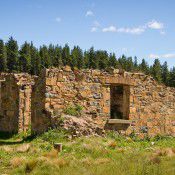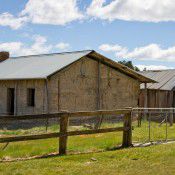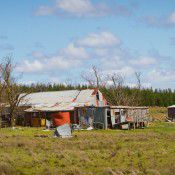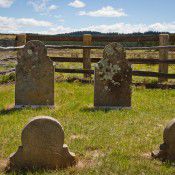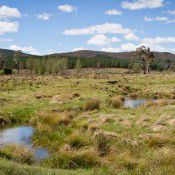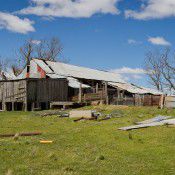JUST past Queanbeyan, where the road to the coast cuts back into the ACT for a few kilometres, a collection of historical gems remains hidden to most Canberrans behind a locked gate on the southern edge of Kowen Forest.
There are at least 12 historical sites in the little Glenburn Creek area, providing tangible links to the first British settlers of our region and insight into how much Australian society has changed since the old days.
“There certainly was quite a vibrant little community here,” explains Col McAlister, an amateur historian who leads drive-and-walk tours of the Glenburn and Burbong area a few times a year, and has agreed to show “CityNews” around.
The area flourished, he says, after the 1861 Robertson Land Acts let poorer people buy land, rather than live under the thumb of wealthy landowners such as the Campbells, the Scottish aristocrats who owned the massive Duntroon Estate.
One site Col shows us is the crumbling stone ruins of the Colliers’ Homestead, which half-stands where it was built, probably by the Campbells on land they didn’t own and couldn’t buy under the Robinson Laws.
“The far room at the end has no internal access,” Col points out. “There was a tradition that if you turned up at a farmhouse, you would always be given accommodation for the night, but in some places, to protect the young children, you only had external access.”
A roughly hewn stone’s throw away is a pile of rubble that used to be Curley’s Hut and at nearby Coppins Homestead, the chimney and fireplace have survived, while only a few scattered bricks remain from the school, established in 1882.
When Kowen Forest was planted in the late 1920s, these remnants of life in the 1800s were not old or rare enough to justify saving.
“We’re lucky that this area, which was originally called Dirty Swamp, was not suitable for pines; that’s the only reason some of the things that are here are left,” says Col, who has lobbied the ACT Government to fund preservation of the area since 2005 and helped form the volunteer group Friends of Glenburn in 2010.
The group was thanked for their countless hours of labour over the last few years by Territory and Municipal Services Minister Shane Rattenbury, who joined them recently to plant two pine trees at Glenburn Homestead, an amazing brick-and-wood cottage that sits beside another made of pise de terre, or “rammed earth”.
Another site is a tumbledown shearing shed: built in the 1860s, extended over the years and still in occasional use, despite looking ready to collapse at any moment.
Then there is the tiny graveyard where six-year-old Elizabeth Colverwell and her five-year-old sister Margaret were buried in 1837 after both tragically drowned.
“There’s a lot of stories about where they drowned,” says Col. “People say either here or in the swamp or even down at the Molonglo River, which is about four clicks away, but I’m convinced they drowned here, and their home would have been about 20, 25 metres over there.”
Col believes their parents Luke and Mary – the Kowen area’s first settlers in 1831 – lie beside them in unmarked graves, along with their sister Eliza, who was born in 1835 and died in her early twenties.
The graves are what sparked McAlister’s advocacy for the heritage area.
In March 2005, he wrote in the “Canberra Historical Journal” of “The Case for Urgent Action” to look after them, pointing out that the oldest marked European burial sites in the ACT – older than most in the region including any in Queanbeyan’s Riverside Cemetery – were lying face-down, neglected.
“The ‘Queanbeyan Age’ took up the challenge,” says Col, explaining that the newspaper’s mini-campaign added to his persistent letter writing until eventually, meetings were held and budgets rearranged.
“Since then, it really has been a fantastic effort and they have found some money,” he says.
“The Parks Service in the last five years has done an absolutely magnificent job, with the help of the Friends of Glenburn and the National Parks Association, and we’ve also had the horticultural school from CIT involved, and the Surveyor-General of the ACT helping us with historical maps and surveys. It’s a real group effort that’s done a lot in the last five years.”
Access to Kowen Forest can be arranged through Canberra Connect. Col McAlister’s drive-and-walk tours are arranged semi-regularly. For more information, email cvmac@grapevine.com.au
The post Hidden glimpse of local, colonial history appeared first on Canberra CityNews.

